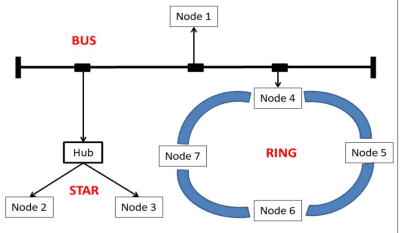What is Computer Networking ?
Computer network is defined as the interconnection of two or more computers. It is done to enable the computers to communicate and share available resources.
The computers that provides the resources to other computers on a network is known as server.
The individual computers in the network which access shared network resource are known as client or node.
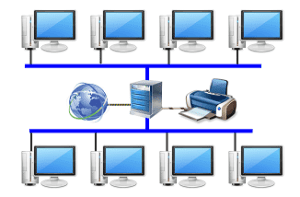
Importance of computer Network
- Sharing of resources such as printers
- Sharing of software’s and database
- Exchange of data and information among users via network
- It allows for the electronic transfer of text.
- It allows for decentralized of various data processing functions
- It allows for communication between organization
- It allows for easier backup process
Advantages of Computer Network
- Increased speed
- Reduced cost
- Improved security
- Electronic mail
- Flexible access
Disadvantages of Computer Network
- High cost of installation
- Requires time for administration
- Failure of server
- Cable faults
Type of Computer Network
Computer Network are clissified based on Geographical area and computer Network architecture.
Network Based on Geography Area
Local Area Network (LAN)
LAN is a network which is designed to operate over a small physical area such as an office, factory or a group of buildings.
LAN’s are easy to design and troubleshoot and Exchange of information and sharing of resources becomes easy because of LAN.
In LAN all machines are connected to a single cable.
Different types of topologies such as star ,tree, bus, ring, etc Can be used.

Advantages
- The reliability of network is high because the failure of one computer in the network does not affect the functioning for other computers
- Addition of new computers to network is easy
- High rate of data transmission is possible
- Peripheral device like printer can be shared by other computers
Disadvantages
- Cover a small geographical region
- Limitation in exchanging information
- Special security measure are need to stop users from using programs and data they should not have access to
- In LAN all machines are connected to a single cable so that if cable failed; it affect entire system.
Metropolitan Area Network (MAN)
It is in between LAN & WAN technology that covers the entire city.
It uses similar technology as LAN.
It can be a single network such as cable TV network, or a measure of connecting a number of LAN’s or a large network so that resources can be shared LAN to LAN as well as device to device.
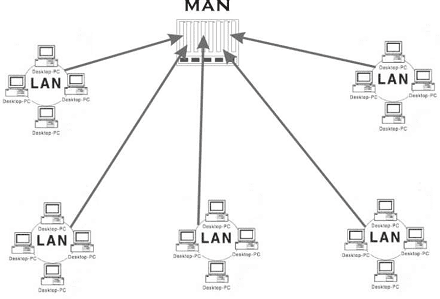
Advantages
- More cable required for a man connection from one place to another.
- Increases the efficiency of handling data.
- Increase the speed of transferring data.
- Saves the cost attached to establish a wide area network.
- Cost effective by Sharing of resources such as printers.
- Offers centralized management of data.
- Enables people to connect many fast LANs together.
- Easy to implement links. üFlexibility of the proposed service.
Disadvantages
- The large the network becomes difficult to mange.
- Difficult to make the system secure from hackers .
Wide Area Network
When network spans over a large distance or when the computers to be connected to each other are at widely separated locations a local area network cannot be used. A wide area network(WAN) is installed.
The communication between different users of WAN is established using leased telephone lines, satellite links and similar channels.
It is cheaper and more efficient to use the phone network for the link.
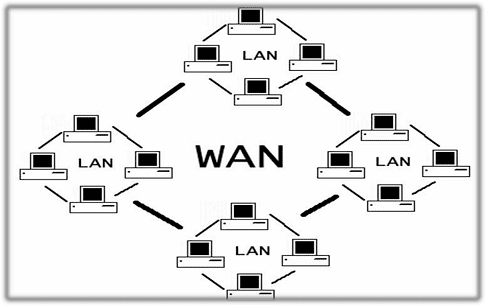
Advantages
- Covers a large geographical area so long distance business can connect on the network.
- Share software and resource with connecting working stations.
- Everyone on the network can use same data. This avoids problems where some user may have older information than others.
Disadvantages
- Network can be expensive and complicated.
- It is slow in speed
- Very much dependency on the third party because it is public network.
Based on Network Architecture
Based on network architecture computer network classified into three types .
- Client server Network
- Peer-to-peer Network
- Value added Network
Client Server Network
The Powerful computers that provides the resources to other computers on a network is known as server.
The individual computers in the network which access shared network resource are known as client or node
In Client server communication :
• Establish connection using protocol
• Client send request to server
• Server sends response to client request
• Close connection
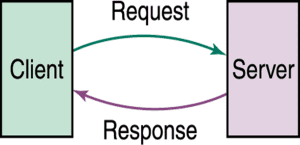
• The server must be faster and more storage capacity to contain all the data, need to be shared to the clients. There are different type of servers:
• File Servers: managing files
• Print server: To handling printing request
• Communication Server: handle the communication between client and server
Mail server: specially setup to handle client’s email
Advantages:
- Centralized Security
- Easy accessibility
Disadvantages:
- Expensive server
- If the server crashes , the computer network breaks down.
Peer to Peer Network
In peer-to-peer network computers are connected individually in pair(one to one connection).
There is no dedicated server. All the computers are equal termed as peers.
Each computer on the network has the capability to share data and resource with other computers.
Each user has right to decide what he would or would not like to share. Each computer act as a both client and server.
It is suitable in small office network.
Advantages:
1.Inexpensive
2.Easy setup and maintenance
Disadvantages:
1.Less secure because message flow freely between the computer.
2.It is decentralized as there is no space for the storage of files.
Value Added Network(VAN)
A third part network performing services beyond the transmission of data. For example, VANs provide mailbox, data security. Many also offer email services.
The connection between two VANs that allows message from one VAN’s customer to be communicated to the customer on the other.
VAN is generally used by the companies privately for Electronic data interchange (EDI), which is standard for interchanging the business data.
Difference Between LAN,MAN and WAN


